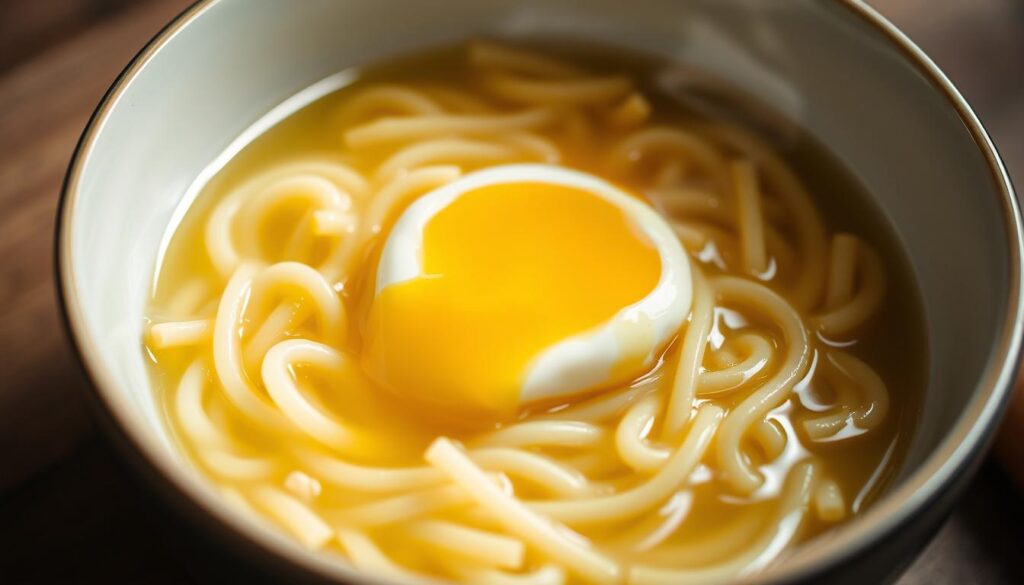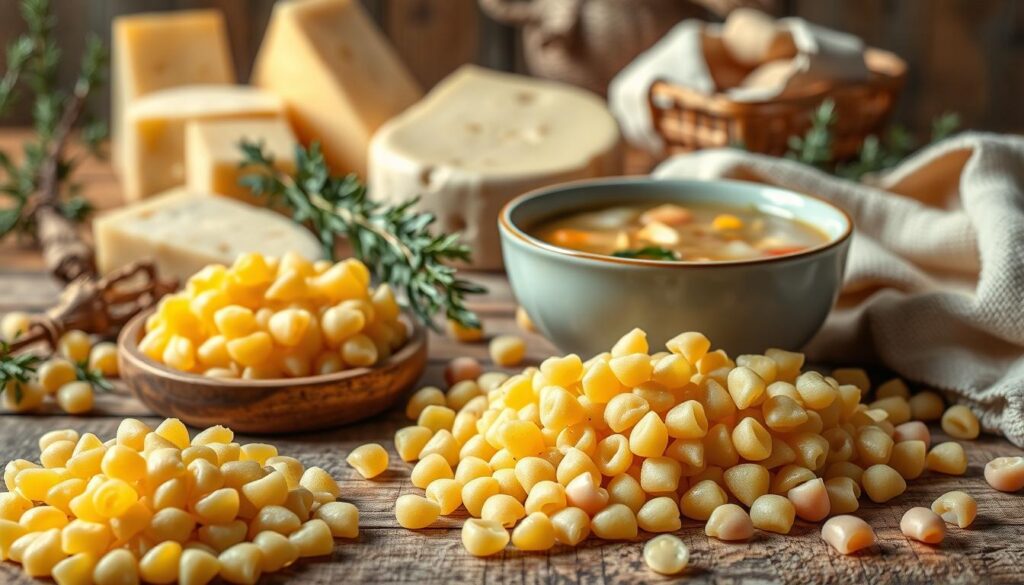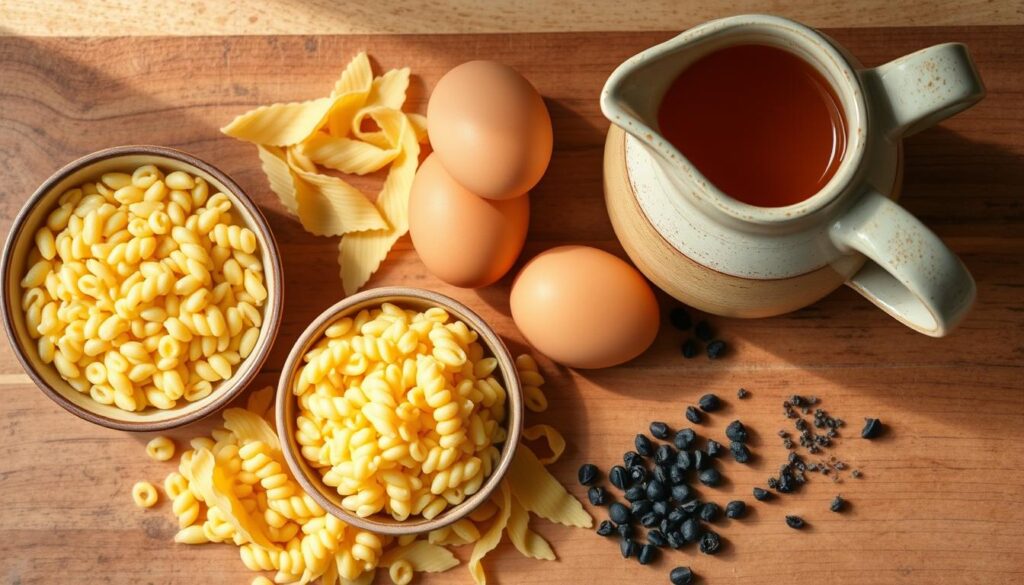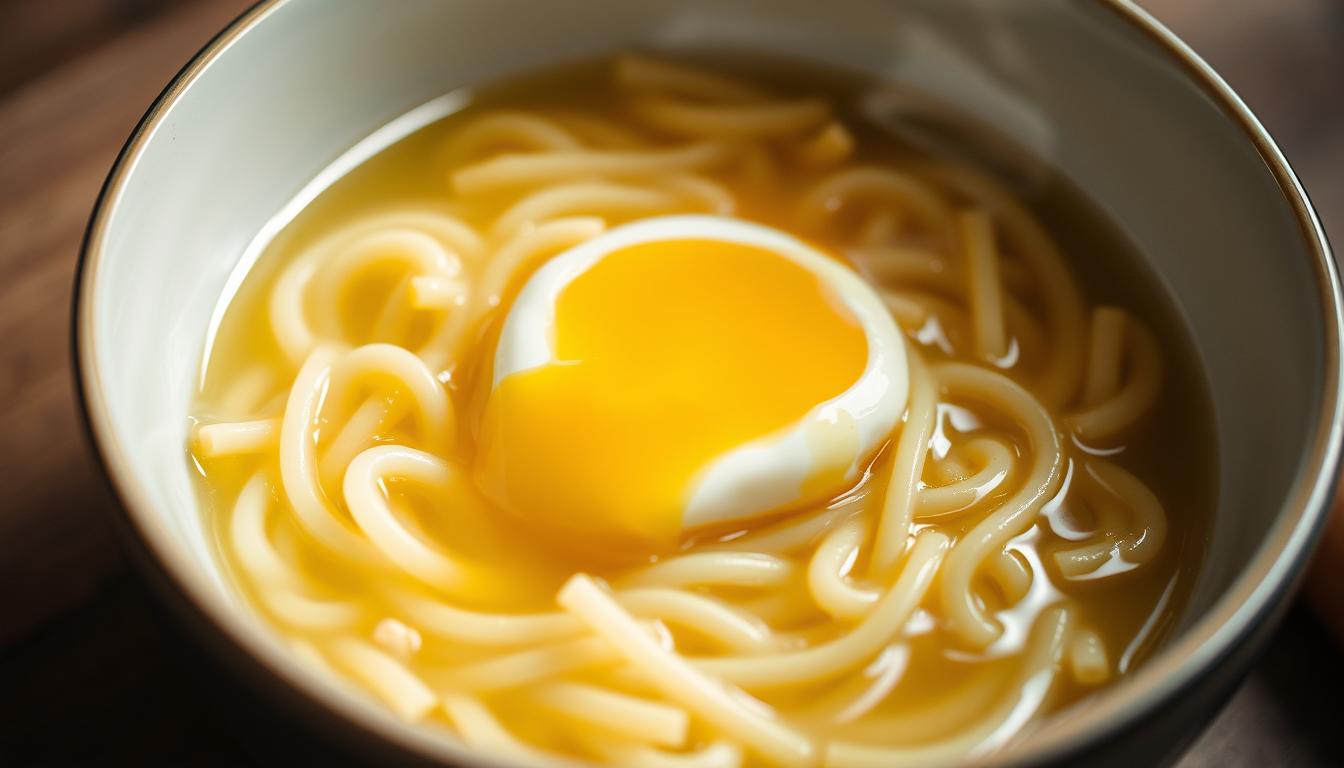
Growing up in an Italian-American kitchen, I remember my grandmother’s pastina with egg. Tiny pasta pearls simmered in rich chicken broth. It was more than a meal; it was a warm hug, healing any childhood sickness or soothing a tired soul.
This pastina recipe is about keeping a cherished tradition alive. Passed down through generations, it stands for comfort, love, and the beauty of Italian home cooking. If you’re feeling sick or just want a taste of home, this dish will comfort you.
Soon, you’ll learn how to make the perfect pastina. It’s a dish so simple yet so satisfying, it’s called “Italian Penicillin” in many homes.
Key Takeaways
- Pastina is a traditional Italian comfort food
- Takes only 4-5 minutes to cook
- Provides essential nutrients and healing properties
- Perfect for children and adults alike
- Can be prepared with minimal ingredients
Table of Contents
Understanding Pastina: Italy’s Beloved Tiny Pasta
Explore the world of pastina, a tiny pasta loved in Italy. Its name means “little pasta” in Italian. It’s a comfort food that brings warmth and nostalgia to many.

Pastina soup is more than a dish; it’s a cultural symbol called Italian penicillin. It’s known for its healing powers and comfort. It’s a favorite for colds and homesickness.
Exploring Pastina Shapes
Pastina comes in many fun shapes, making your soup playful. Here are some favorites:
- Stelline (tiny stars)
- Acini di pepe (tiny pepper seeds)
- Orzo (rice-shaped)
- Alphabets
- Tiny circles
The Healing Power of Italian Penicillin Soup
Italians see pastina soup as a natural cure. Its simple ingredients and caring nature make it a top comfort food. It’s like chicken noodle soup to Americans.
“Pastina is not just food, it’s a warm hug in a bowl” – Italian Grandmother Wisdom
Traditional Culinary Uses
Pastina is used in many ways in Italian cooking. It’s not just for soup.
- Baby food
- Light meals during illness
- Quick family dinners
- Side dishes
Pastina soup is a special treat that goes beyond just eating. It brings comfort and a taste of Italy to your table.
Essential Ingredients for Perfect Pastina

Learning to make pastina begins with picking the right ingredients. This traditional Italian dish needs a few key parts to become a tasty meal.
The main ingredients for making real pastina are:
- Pastina pasta – tiny star-shaped or alphabet pasta
- High-quality chicken stock
- Unsalted butter
- Freshly grated Parmigiano Reggiano cheese
Choosing the right ingredients is important. Use authentic Italian pastina pasta, if possible. The small pasta shape soaks up broth well, making the dish creamy.
You can also add some extra ingredients to make your pastina even better:
- Fresh eggs for added richness
- Finely chopped herbs
- Sautéed vegetables
- Freshly ground black pepper
The broth you choose can change the taste a lot. Homemade broth is best for real flavor, but good store-bought broth works too when you’re short on time.
“The secret to perfect pastina lies in using fresh, high-quality ingredients and cooking with love.” – Italian Cooking Tradition
The Power of Homemade Chicken Broth
Making the best pastina soup begins with a great chicken broth. A rich, flavorful broth turns your soup into something special. It’s all about creating a broth that’s both deep in flavor and full of nutrients.
Crafting Your Perfect Chicken Broth
Homemade chicken broth is easy to make with just a few ingredients and some time. You’ll need:
- Fresh chicken bones
- Aromatic vegetables (onions, carrots, celery)
- Bay leaves
- Whole peppercorns
- Fresh herbs
Store-Bought Broth Alternatives
If making your own broth isn’t an option, choose high-quality store-bought ones. Opt for brands with few additives and lots of flavor. Organic, low-sodium chicken broths are best for pastina soup.
Benefits of Premium Broth
Using top-notch broth improves both taste and health benefits. A good broth adds important minerals, boosts your immune system, and makes your soup comforting. Look for broths with:
- 8 cups of nutrient-dense liquid
- Low sodium content
- Natural ingredients
- Rich protein profile
Your pastina soup needs a strong foundation, just like generations of cooks have used. Whether you make it yourself or pick the best store-bought, the right broth is key.
Pastina with Egg: Classic Recipe Method
Making perfect pastina with egg needs care and skill. This Italian dish is quick to make. It’s great for those who want a warm, comforting meal fast.
First, gather these key ingredients:
- 1 cup pastina pasta
- 4 cups chicken stock
- 50 grams butter
- 1 egg (optional)
- 1/2 cup grated pecorino romano cheese
To cook pastina with egg, start by boiling chicken stock in a pot. Add the pastina and stir gently to avoid sticking.
Lower the heat and add butter, stirring constantly. This makes the pastina creamy as it absorbs most of the liquid. It makes each pasta grain tender and plump.
For a richer dish, temper an egg. Whisk it, then mix in a bit of hot pastina to avoid scrambling. Fold the egg into the dish for a smooth texture.
Tip: Add more grated pecorino romano cheese on top for extra flavor. Your pastina with egg is now ready to warm hearts and comfort souls!
| Ingredient | Quantity | Purpose |
|---|---|---|
| Pastina | 1 cup | Base of the dish |
| Chicken Stock | 4 cups | Liquid and flavor |
| Butter | 50 grams | Creaminess |
| Egg | 1 | Optional enrichment |
Remember, pastina is not just a meal – it’s a culinary tradition passed down through generations of Italian families.
Mastering the Perfect Consistency
Learning to make pastina means getting the texture just right. It’s all about creating a creamy, comforting dish. To achieve this, you need to pay close attention and use specific techniques.
- Use the right liquid-to-pasta ratio
- Maintain consistent stirring
- Watch cooking time carefully
- Control heat precisely
Expert Tips for Ideal Texture
Focus on these key points when making pastina:
- Liquid Absorption: Pastina should soak up about 80% of the liquid
- Stirring Technique: Stir gently but often to avoid sticking and ensure even cooking
- Heat Management: Use a steady medium-low heat to prevent overcooking
Avoiding Common Cooking Mistakes
| Mistake | Solution |
|---|---|
| Overcooking | Remove from heat when pasta is al dente |
| Too Much Liquid | Use precise measurements (1 cup pastina to 4 cups broth) |
| Uneven Cooking | Stir consistently and maintain low heat |
By following these tips, you’ll make perfectly textured pastina every time. It turns a simple dish into a true culinary delight.
Adding Flavor Enhancements and Variations
Your pastina recipe can become a culinary adventure with a few creative touches. Every Italian family has its own twist on this beloved dish. This makes each pastina recipe a personal expression of flavor and tradition.
- Add fresh herbs like basil, parsley, or oregano for a burst of flavor
- Incorporate grated Parmesan or pecorino cheese for richness
- Mix in sautéed vegetables like spinach or peas
- Experiment with protein additions such as shredded chicken or crispy pancetta
Regional variations can inspire your pastina recipe. Some Italian regions like a soupy consistency, while others prefer a risotto-like texture. The key is to experiment and find your perfect balance.
| Style | Consistency | Key Ingredients |
|---|---|---|
| Northern Italian | Thick, creamy | Butter, Parmesan |
| Southern Italian | Broth-based, lighter | Olive oil, herbs |
Don’t be afraid to get creative with your pastina recipe. Each variation tells a story of culinary tradition and personal taste.
Health Benefits and Nutritional Value
Pastina, also known as the italian penicillin soup, is more than a comforting meal. It’s packed with nutrients that help you recover and feel better. Made with rich chicken broth and a fresh egg, it becomes a healing dish for both body and soul.
Protein and Mineral Powerhouse
Your italian sick soup is not only delicious but also very nutritious. Here’s why pastina stands out:
- High-quality protein from eggs and chicken broth
- Essential minerals like calcium and iron
- Easy-to-digest carbohydrates for quick energy
- Hydrating liquid base that supports recovery
Why It’s Great for Recovery
When you’re feeling sick, pastina offers amazing healing benefits. The warm broth helps keep you hydrated. The small pasta size is gentle on your stomach. It’s packed with nutrients that boost your immune system and offer comfort when you’re not feeling well.
“A bowl of pastina can cure any cold and mend a broken heart” – Italian Grandmother Wisdom
Pastina’s mix of carbs, proteins, and minerals makes it a balanced meal. It helps keep your energy stable and supports your overall health. Whether you’re battling a cold or just need a nutritious boost, this traditional italian penicillin soup is a trusted remedy for many.
Serving Suggestions and Pairings
Your pastina recipe is ready for some creative serving ideas. These ideas will make your meal more special, whether you’re at home or on the go. They’ll make your pastina experience even better.
Pastina is super versatile, making it great for many meals. Here are some fun ways to serve your pastina:
- Cozy Comfort Style: Serve in your favorite oversized mug while wearing soft pajamas
- Elegant Appetizer: Garnish with fresh herbs and grated Parmesan cheese
- Protein Boost: Add shredded chicken or scrambled eggs
- Vegetarian Option: Mix in roasted vegetables like zucchini or spinach
Drinks can make your pastina meal even more special. Try these drinks with your pastina:
- Warm Options: Herbal tea or light chicken broth
- Cold Options: Crisp white wine or sparkling water with lemon
For parties, serve pastina in small ramekins or decorative bowls. Keep it simple yet appealing.
Pro tip: Pastina is best enjoyed slowly, savoring each comforting spoonful!
Storage Tips and Reheating Instructions
Your delicious pastina recipe needs careful handling after cooking. Fresh pastina is always best. But sometimes, you’ll have leftovers that need proper storage and reheating.
When storing your pastina recipe, follow these key guidelines:
- Cool the pastina completely before storing
- Use an airtight container for refrigeration
- Store for only 2-3 days maximum
- Avoid freezing to maintain texture
Reheating requires special attention to preserve the creamy consistency of your pastina recipe. Microwaving can destroy the delicate texture, so choose a gentler method:
- Place pastina in a small pot
- Add a splash of chicken broth
- Warm over low heat
- Stir frequently to prevent sticking
- Remove once heated throughout
| Storage Method | Duration | Recommended Technique |
|---|---|---|
| Refrigeration | 2-3 days | Airtight container |
| Reheating | 5-7 minutes | Low heat with broth |
Remember that pastina naturally thickens when refrigerated. A little extra broth during reheating will help restore its original creamy consistency. This keeps your pastina recipe tasting fresh and delicious.
Traditional Family Recipes and Cultural Significance
Pastina is more than a dish; it’s a treasured tradition in Italian families. It symbolizes comfort, love, and healing. Known as the Italian penicillin soup, it has helped many generations feel better.
In Italian homes, pastina holds a special place. It’s often the first solid food for babies and a cure for the sick. Its simplicity hides a deep emotional value.
- Traditionally served as a healing meal
- Symbol of maternal care and comfort
- Represents generational culinary wisdom
Pastina varies across Italy, showing its flexibility. From Lombardy in the north to Sicily in the south, each family has its own way of making it. The recipe may differ, but the goal is always the same: to offer warmth, nutrition, and love.
| Region | Unique Pastina Preparation |
|---|---|
| Lombardy | Butter and Parmesan emphasis |
| Sicily | Often includes local herbs |
| Tuscany | Incorporates local vegetable broths |
For Italian-Americans, pastina is a link to their heritage. It connects the past and present through food. Every spoonful brings back memories of grandmothers making this italian penicillin soup. It turns a simple meal into a powerful act of family love.
Conclusion
As we finish our look at pastina with egg, you’ve learned it’s more than a simple pasta dish. It’s a comforting Italian tradition that turns simple ingredients into a nourishing meal in under 30 minutes. Your pastina soup can be tailored to your taste and nutritional needs, with 22g of protein per serving.
Pastina’s charm comes from its simplicity and cultural importance. It’s perfect for a quick dinner or a taste of family history. With cooking times of 5-7 minutes, you can make a tasty dish for four, full of nutrients and flavor.
Pastina is more than a meal; it’s a link to Italian culinary heritage. By learning this recipe, you’re keeping a tradition alive that has comforted many. From being a first solid food for Italian babies to a beloved comfort dish, pastina brings people together, one bowl at a time.
Your journey with pastina is just starting. Try new variations, explore different broths, and make it your own. With its quick prep and flexibility, pastina is set to become a favorite in your kitchen. It offers a delicious and nutritious meal that feels like a warm hug.

